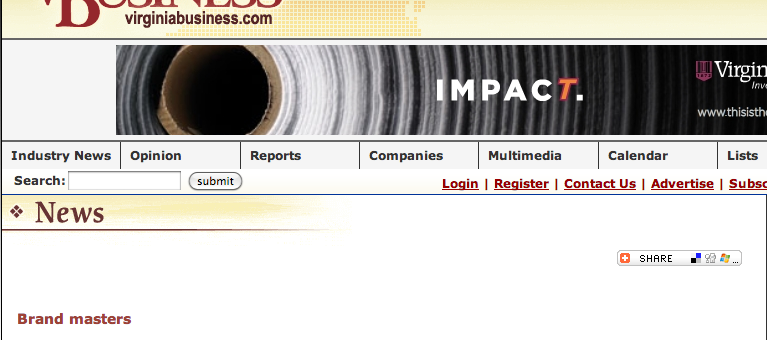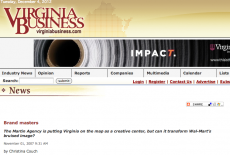Businesses Invest in a Work Force That’s Still on Training Wheels
Published in the July 1, 2008 issue of Virginia Business Magazine
Toddlers may be 20 years from entering the work force, but Virginia companies already are trying to boost their résumés. In conjunction with the United Way, a handful of Virginia companies are making an investment in the region’s future labor supply … and they’re expecting high returns.
“The moral imperative to do right by children is pretty obvious, but there’s a strong economic imperative, too,” says Katherine Busser, executive vice president of Capital One Financial Corp. “We’re focused on creating the work force of the future.”
In the past three years, Capital One has donated more than $1 million to educational projects and more than 700 hours of volunteer time to Success By 6. That initiative, involving businesses, the Greater Richmond Chamber of Commerce and the United Way, is aimed at improving the state’s early childhood education programs.
Studies show that when businesses invest in children under the age of 5, their investment pays dividends. Students who enter kindergarten armed with basic knowledge of colors, numbers and the alphabet — as well as developed social skills — are less likely to fail grade levels, drop out of high school, get arrested or go on welfare.
The Federal Reserve of Minneapolis estimates that local communities reap an impressive $17 return for every dollar they invest in early childhood education because of reduced crime and poverty rates, higher income tax dollars and an educated work force.
For businesses, having a qualified work force in their community fiscally trumps dishing out dollars to recruit one, says Sherrie Brach, president and CEO of the United Way of Greater Richmond and Petersburg. “If you look at companies like Dominion [Resources], 30 percent of its work force is going to be retiring soon. The challenge that’s happening is that they’re not getting qualified people to take over those jobs,” says Brach.
Brach believes that the most efficient way to prepare a capable, college-educated work force is to prepare strong students long before they step foot in a kindergarten classroom. “Ninety percent of a child’s brain is fully developed by age three, so if that brain isn’t being stimulated, and it’s not getting all that it needs to make those connections later on, they immediately fall behind and they start school never able to catch up,” she says. “If a child is in the third grade and they’re not reading at level, it’s almost too late. We are setting them up to fail.”
With nine chapters spread throughout the state, Success By 6 tries to bring soon-to-be Virginia kindergartners up to speed in two ways. First, the initiative provides community outreach and home visitation programs that educate parents on what children need to know before entering school. It also aims to improve child-care centers by helping statewide preschools, day care and early learning centers reach national accreditation standards.
“In terms of early childhood education, Virginia has barely begun to scratch the surface,” says Scott Hippert, president of the Virginia Early Childhood Foundation, a Richmond-based nonprofit that provides grants, training and technical assistance to Success by 6 chapters. “Here in Virginia and across the nation, one out of three kids that enters kindergarten isn’t ready to learn. It’s going to require support from the private sector, support from the nonprofit sector and support from the commonwealth to change that … If we want Virginia to be a global economic leader, we have a long way to go.”
Jim Dunn, president and CEO of the Greater Richmond Chamber of Commerce, adds that investing in early childhood education isn’t just about keeping Virginia companies satisfied. With the upcoming labor shortage, prospective companies looking to invest in the region are asking not only about the current labor supply, but the future one as well. “Now when companies come in, they want to know what educational opportunities we offer for young people. One of the biggest questions that we get from prospects is if they make an investment in our region, are we going to be able to provide the work force that they need for years to come,” Dunn says. “It’s important that we can put a future work force through the pipeline that will encourage employers in our region that they can operate profitably in our marketplace.”
In terms of securing Virginia’s future work force, the state has made significant strides in the past few years. Last August, Gov. Timothy M. Kaine proposed a five-year Start Strong initiative that would place 17,000 more of the state’s at-risk 4-year-olds in high-quality preschools by 2012. Although the General Assembly rejected Kaine’s initial request for $40 million to get Start Strong off the ground, the governor did win an additional $22 million to expand on the state’s pre-K programs starting July 1.
“That will put another 2,000 to 3,000 kids into the system over the course of two years,” says Gordon Hickey, Kaine’s press secretary. “The governor feels strongly that universal pre-K is good for Virginia, and he believes that some day it will be so. It’s just a matter of slowly moving in that direction. It’s not going to happen overnight.”
Until then, it’s up to the private and nonprofit sectors to compensate and that means convincing those with money that investing in education isn’t charity; it’s a business venture.
“We very much value the economic reasons for making this investment,” says Katherine Busser of Capital One. “We’re a bank, for goodness sake. We understand the return on the investment as well as anyone.”
— Christina Couch






